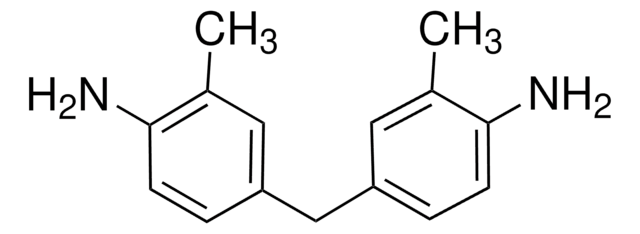31629
o-Aminoazotoluene
analytical standard
Synonym(s):
4′-Amino-2,3′-dimethylazobenzene, Solvent Yellow 3
About This Item
Recommended Products
grade
analytical standard
Quality Level
shelf life
limited shelf life, expiry date on the label
technique(s)
HPLC: suitable
gas chromatography (GC): suitable
mp
101-102 °C (lit.)
application(s)
cleaning products
cosmetics
environmental
food and beverages
personal care
format
neat
SMILES string
Cc1ccccc1\N=N\c2ccc(N)c(C)c2
InChI
1S/C14H15N3/c1-10-5-3-4-6-14(10)17-16-12-7-8-13(15)11(2)9-12/h3-9H,15H2,1-2H3/b17-16+
InChI key
PFRYFZZSECNQOL-WUKNDPDISA-N
Looking for similar products? Visit Product Comparison Guide
General description
Application
- Dyes, cosmetics, inks and finger paints using liquid chromatography coupled to mass spectrometry (LC-MS).
- Commercial samples including food packaging plastic, multilayer plastic laminates and recycled paperboard categories using liquid chromatography coupled to mass spectrometry (LC-MS) technique.
Caution
signalword
Danger
hcodes
Hazard Classifications
Acute Tox. 3 Oral - Carc. 1B - Eye Irrit. 2 - Skin Irrit. 2 - Skin Sens. 1
Storage Class
6.1C - Combustible acute toxic Cat.3 / toxic compounds or compounds which causing chronic effects
wgk_germany
WGK 3
flash_point_f
Not applicable
flash_point_c
Not applicable
ppe
Eyeshields, Faceshields, Gloves, type P2 (EN 143) respirator cartridges
Choose from one of the most recent versions:
Already Own This Product?
Find documentation for the products that you have recently purchased in the Document Library.
Customers Also Viewed
Our team of scientists has experience in all areas of research including Life Science, Material Science, Chemical Synthesis, Chromatography, Analytical and many others.
Contact Technical Service









